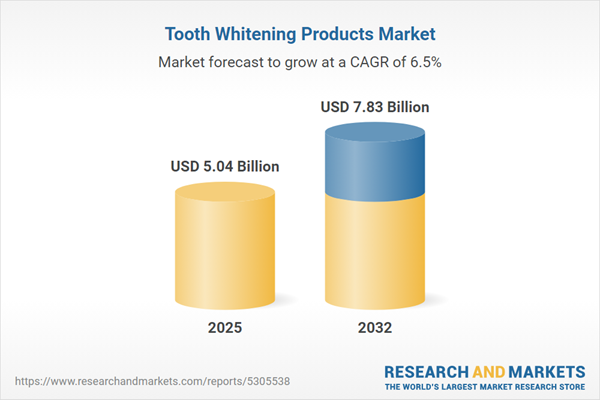Speak directly to the analyst to clarify any post sales queries you may have.
Senior executives pursuing growth in the tooth whitening products market require actionable intelligence as they navigate a landscape influenced by innovation, regulatory shifts, and evolving customer demands. Strategic adaptation to buyer preferences and emerging technology is critical for sustaining success in this sector.
Market Snapshot: Tooth Whitening Products Market
The global tooth whitening products market reached USD 4.73 billion in 2024, reflecting strong demand across B2B and B2C channels. The sector demonstrates robust momentum, with forecasts indicating USD 5.04 billion in 2025 and USD 7.83 billion by 2032, supported by heightened consumer interest in cosmetic dental care and continuous advancements in digital platforms. Companies in this space are sharply focused on R&D and implementing agile supply chain strategies, both of which contribute to sector resilience and broadened market relevance worldwide.
Scope & Segmentation
- Product Types: Whitening gels, strips, pens, mouthwashes, toothpastes, and clinical-grade formulations serve both at-home users and dental professionals, ensuring applicability across multiple market segments.
- Active Ingredient Types: Charcoal-based, enzyme-activated, and peroxide-driven options cater to a spectrum of client needs, from gentler choices for sensitive users to fast-acting and specialized formulas for targeted whitening.
- Distribution Channels: Pharmacies, beauty outlets, dental practices, supermarkets, and digital platforms are vital for market penetration, providing broad access and flexibility in response to market demand shifts.
- Regional Coverage: The Americas, Europe, Middle East & Africa, and Asia-Pacific constitute key growth areas, each requiring adaptation to unique regulatory environments and buyer attitudes for effective market expansion.
- Companies Profiled: Leading firms such as Colgate-Palmolive, The Procter & Gamble Company, Haleon plc, Unilever PLC, Church & Dwight Co., Inc., Johnson & Johnson Services, Inc., Koninklijke Philips N.V., 3M Company, Ultradent Products, Inc., and Kao Corporation drive innovation and shape competitive dynamics across the industry.
Key Takeaways for Senior Decision-Makers
- At-home whitening solutions are driving changes in product development and positioning, emphasizing the blend of ease-of-use with professional results.
- Full transparency regarding ingredients and company standing is key, supporting greater buyer trust and facilitating compliance across regions.
- Partnerships with dental professionals not only enhance brand reputation but also expand demographic access and strengthen educational outreach.
- Procurement priorities increasingly include sustainability, such as ethical sourcing and recyclable packaging, which align with corporate responsibility and broader stakeholder expectations.
- Digital engagement tools, including virtual consultations and integrated e-commerce, foster tailored customer experiences and more granular marketing tactics.
- Region-specific promotional and compliance adaptation mitigates operational risk and enables sustainable, agile growth strategies in diverse markets.
Tariff Impact: Responding to United States Tariffs
Recent tariff measures on dental and cosmetic imports in the United States have prompted market leaders to explore adjustments such as increasing local sourcing, renegotiating supply contracts, and recalibrating pricing structures. These responses are designed to protect margins and maintain competitiveness under changing regulatory frameworks.
Methodology & Data Sources
This market analysis uses insights from executive interviews, expert product assessment, and discussion group feedback. Results are benchmarked against authoritative industry reports and substantiated by reliable quantitative data to enable well-informed strategic planning.
Why This Report Matters
- Empowers executive leadership to track technological innovations, keep pace with regulatory developments, and pinpoint major growth drivers in the tooth whitening products market.
- Supports the identification of timely business opportunities and helps organizations proactively manage risks related to operations, compliance, and international supply chains.
- Provides actionable recommendations for aligning business strategies with evolving regional market expectations and advancing long-term sustainability.
Conclusion
Continued market success requires senior executives to prioritize regulatory awareness, foster innovation, and maintain agility in addressing shifting customer needs and sustainability requirements.
Additional Product Information:
- Purchase of this report includes 1 year online access with quarterly updates.
- This report can be updated on request. Please contact our Customer Experience team using the Ask a Question widget on our website.
Table of Contents
3. Executive Summary
4. Market Overview
7. Cumulative Impact of Artificial Intelligence 2025
Companies Mentioned
The companies profiled in this Tooth Whitening Products market report include:- Colgate-Palmolive Company
- The Procter & Gamble Company
- Haleon PLC
- Unilever PLC
- Church & Dwight Co., Inc.
- Johnson & Johnson Services, Inc.
- Koninklijke Philips N.V.
- 3M Company
- Ultradent Products, Inc.
- Kao Corporation
Table Information
| Report Attribute | Details |
|---|---|
| No. of Pages | 182 |
| Published | November 2025 |
| Forecast Period | 2025 - 2032 |
| Estimated Market Value ( USD | $ 5.04 Billion |
| Forecasted Market Value ( USD | $ 7.83 Billion |
| Compound Annual Growth Rate | 6.5% |
| Regions Covered | Global |
| No. of Companies Mentioned | 11 |









